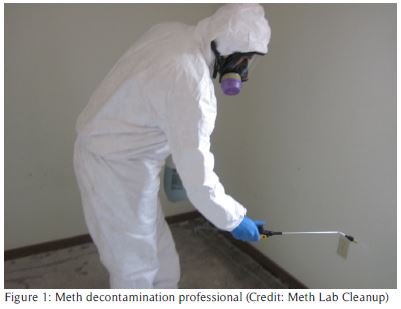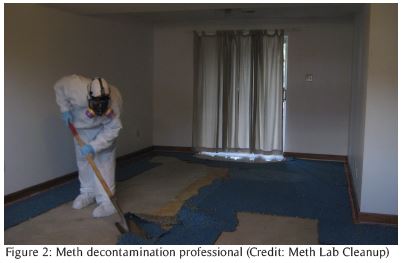 |
> OREP Home Inspector E&O/GL Insurance- apply, quote, and purchase in minutes. Minimum premium $1,000- many incidental coverages included. “A” Admitted Carrier. Shop Now! |
Meth and Home Inspection
By Julie A. Mazzuca, Co-Founder of Meth Lab Cleanup®
What is “meth”? It stands for methamphetamine, also known as, “speed,” “crank,” “crystal” and “ice.” There are many different recipes for “cooking” meth. All of the methods of manufacturing methamphetamine involve dangerous chemicals and reagents/substances that are considered harmful to humans. The residues that remain after the cooking process can remain on surfaces for months or years after the cooking is over. Even though the chemicals used can be obtained at the local hardware store, they can create serious problems for the innocent victim.
Scope of Problem
In the last 10 years there has been an enormous increase in the number of clandestine drug labs across America; meth labs are the most prevalent. The Drug Enforcement Administration (DEA) seized more than 100,000 labs between 2004 and 2015. The DEA estimates that only one in 10 labs are discovered– so there may be more than 900,000 unidentified clandestine drug labs in the U.S. right now. These numbers do not include other state and local law enforcement statistics. The Oklahoma Bureau of Narcotics estimates that there are over 250,000 legacy labs in their state alone.
Many believe that the regulations that impose limitations on the availability of many of the precursors necessary to manufacture a drug such as ephedrine or pseudoephedrine, are responsible for a decline in production. The truth is, the criminals involved in this type of illegal activity are very resourceful and have discovered ways to operate which allow them to be completely mobile. This fact alone makes it increasingly harder for law enforcement and the general public to detect a lab.
The illegal use of private properties as drug labs is becoming one of the biggest problems property owners and representatives are facing. Clandestine labs are being discovered in a very large number of homes, apartments, vehicles, trailers, storage units and vacant buildings across the country. Current statistics say that there are more than a million labs in America and the numbers are still rising.
Many of the properties that are identified as former meth labs are discovered through means other than law enforcement. Contamination is often discovered during a property assessment in response to health complaints by occupants, information from neighbors regarding a prior occupant or as part of a real estate transaction.
Property Contamination
Why should this matter to a home inspector? It is simple: during the meth manufacturing process, chemical compounds become airborne (volatilized) and settle out, depositing onto walls, ceilings, appliances, floors, carpets and other typical household items throughout the structure’s interior. Additionally, the chemicals used to make the illegal drugs may be spilled during handling. Not only are the production chemicals hazardous, meth use can also contaminate a property. The manufacture of this drug has caused billions of dollars in property damage and most importantly, has become a major health hazard. In almost all cases the residue contamination left behind after a cook can pose serious health risks.
Current studies indicate that there are side effects which are a result of exposure to this type of contamination. These results are classified into two categories: acute and chronic. Although the acute effects are easily detectible, the chronic effects are yet to be determined because there is insufficient data available to document the risk. However, we do know that many of the chemicals used are known to cause long-term health effects on humans. Even though the chemicals used can be obtained at the local hardware store, they can create serious problems for the innocent victim.
(story continues below)
(story continues)
Due to the seriousness of this problem, over two dozen states have adopted regulatory testing and decontamination standards, and many more will follow suit before the end of the decade. Properties in which law enforcement has made an arrest or properties that a health department has deemed unfit, in most instances, have posted signs at the entry warning of possible chemical contamination. Occupation of properties where meth labs have been discovered will usually be prohibited until after assessment and/or remediation by a certified clandestine drug lab decontamination contractor, in accordance with the law. The warning signs prohibit anyone from entering the property unless they are certified to do so.
Meth Screening Service
Many home inspectors throughout the United States are now offering meth residue screenings as an additional service. These inspectors are testing properties that have not been posted as uninhabitable.
Home inspectors offering methamphetamine sampling can choose between two different kinds of sampling; immunoassay (semi-quantitative onsite results) or laboratory analyzed (numerical, processed at a laboratory) or a combination thereof. Meth testing kits are readily available on the Internet. Please choose your sampling products wisely. Not all kits are of equal quality. It should be noted that meth screenings apply to situations where there is no evidence of a meth lab. Meth screenings are often conducted to gain information regarding potential meth use or production contamination at the property. These screenings are usually outside the scope of most state’s clandestine drug lab cleanup regulations. Visit http://www.methlabcleanup.com/meth cleanup laws.htm to view state regulations.
Meth screenings include both visual inspection and methamphetamine residue sampling. Caution should be taken when entering or investigating any property. The process of inspecting and sampling for methamphetamine has the potential for hazard exposure. If you are working for yourself, the choice of personal protection is up to you. Remember—companies with employees must comply with OSHA. When performing meth screenings, the following should be collected and documented:
• Property description, including physical address, legal description, layout of the property, structural features, etc.
• Photographic documentation of site.
• Hazardous chemical use or storage areas, waste disposal areas, cooking areas, chemical stains, fire damage, and other observable damage.
• Information about surfaces, furnishings, and appliances.
• Inspection of HVAC system. Vents, ductwork, filters, walls and ceilings near ventilation ducts frequently become contaminated. Contamination levels in HVAC systems are often 25 times higher than the household average.
• Inspection of garages, barns and other outbuildings.
• Inspection of plumbing, septic, and sewer systems. Most liquid chemical byproducts are dumped into bathtubs, sinks, drains, and toilets. These chemicals can collect in drains, traps and septic tanks. Plumbing fixtures that are visibly contaminated beyond normal household wear and tear should be noted (chemical etching, chemical staining or chemical odors present).
• Identification of adjacent areas/units in multiple dwellings that may require cleaning.
• Outdoor inspection for evidence of burn or trash pits, discolored soil or dead vegetation, indicating possible contamination of water and/or soil.
• Inspector name, signature and date of the inspection.
“Cooks” in meth labs often burn or dump solid wastes outside the structure. Inspectors must note if there is evidence of a release of a hazardous substance in the environment outside the property, i.e., soil staining, spills, chemical containers with wastes or residues, evidence of burning or burying of meth wastes, suspected water well contamination, stream contamination or a similar condition.
Call 911
If visual evidence exists and the laboratory results from the meth samples indicate the presence of methamphetamine residue, a certified clandestine drug lab technician must be contacted for further assessment and testing. The certified contractor shall conduct a Preliminary Assessment of the property and all structures on the property. This information will be critical to how the property should be effectively and safely decontaminated. Figure 1 shows a remediation professional in the decontamination process.

None of the properties you enter should have a functioning lab in process. However, if you do encounter a lab set up, do not attempt to dismantle or turn anything on or off. You should immediately call local law enforcement. In most areas of the U.S., fire departments and law enforcement teams have specially trained personnel who are capable of addressing a meth lab safely and appropriately. However, in some cases, you may time of an arrest. Inspectors should report immediate hazards right away and remove themselves from danger.
This is merely an overview of the screening process. Additional training is recommended with online courses available. Remember that manufacturing methods of methamphetamine and the chemical hazards involved will change.
Removal vs. Decontamination
Remediation of a clandestine drug lab generally consists of two specific phases of work: removal and decontamination. Removal occurs when a meth lab is identified and seized by the state police or local law enforcement, and bulk chemicals, containers, equipment and wastes are removed by specially trained police or fire department officers. Decontamination occurs when a certified clandestine drug lab decontamination contractor removes the remaining household debris and cleans all surfaces using detergents and industrial equipment.

For many years it was thought that a meth lab property could not be decontaminated, which usually led to its destruction. In many areas of the country this is still the common practice. Now, because of science and technology, many of these properties can be saved for much less than the price of replacement. Over 90% of contaminated properties can be decontaminated successfully.
The fact that a residence was used for illegal drug manufacture can also stigmatize the property. Stigma is an intangible factor, which may not be measureable in terms of cost to cure, but may affect market value. It may be seen as a stain on a property resulting from real or perceived risk. Those uneducated in clandestine drug lab remediation may overstate the negative value associated with the property. Furthermore, the presence of these chemicals may cause potential liability to property owners.
Conclusion
This article was developed to outline methamphetamine production, health risks and a general outline for methamphetamine screening. The recommendations come from available information of the known physical properties of the chemicals associated with drug production, current state regulations, and years of field experience in methamphetamine properties.
It is important that you know if you are doing business in a state that regulates testing and clean up. Keep in mind, some county and/or cities have their own cleanup ordinances. Again, please check the Meth Lab Cleanup® Company website for current regulatory status. Contact local authorities for further information on city or county ordinances.
About the Author
Julie A. Mazzuca is the Co-Founder of Meth Lab Cleanup® Company, the most respected clandestine drug lab decontamination contractor in the nation. Meth Lab Cleanup® provides test sampling kits to home inspectors and other remediation professionals. Home inspectors can diversify and grow their income by adding this value-added service.
> Free Webinar: Claims and Complaints: How to Stay Out of Trouble
Available Now
Presenter: David Brauner, Senior Insurance Broker OREP
David Brauner, Senior Broker at OREP, shares insights and advice gained over 20+ years of providing E&O insurance for inspectors, showing you how to protect yourself and your business. Watch Now!
(Get a quick E&O/GL quote from OREP in 30 seconds. Premiums begin around $1,000.)




by Elizabeth White
My husband has been smoking and possibly manufacturing meth in MY HOME. He started to blow the smoke up my nose while I sleep and I caught him lighting a meth fire in the room where I was supposed to be asleep. He tries to clean residue himself which makes renders me without proof . I need proof.
-by Sherry Wagner
Wow aren’t you sick from all that . I’m allergic to it and it sets me on fire and I start throwing up and can’t stop. Hey. Get you a carbon monoxide detector all that he is sucking in and blowing out is straight CARBON MONOXIDE poisoning.
-by scarpe nike air jordan fusion 9 low ls
nike air max lebron 7 xmas hombreadidas campus 80s mita uomojordan 6 rings donnascarpe pumas vulc
-scarpe nike air jordan fusion 9 low ls http://www.alltheorems.com/generalize/scarpe-nike-air-jordan-fusion-9-low-ls
by Vickey Honeycutt
I need a company that can come in a house and test for meth. It is in the police report that there had been a meth lab in it, which there was not. But before they can move back in a company has to come in and inspect it . Please let us know if your company does this type of work ??
-